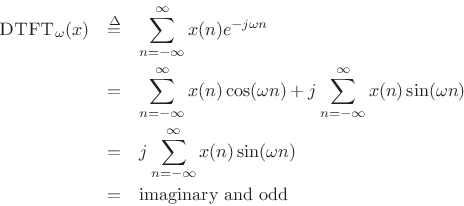Symmetry of the DTFT for Real Signals
Most (if not all) of the signals we deal with in practice are real signals. Here we note some spectral symmetries associated with real signals.
DTFT of Real Signals
The previous section established that the spectrum ![]() of every real
signal
of every real
signal ![]() satisfies
satisfies
| (3.16) |
I.e.,
 |
(3.17) |
In other terms, if a signal
- The real part is even, while the imaginary part is odd:

- The magnitude is even, while the phase is odd:

Real Even (or Odd) Signals
If a signal is even in addition to being real, then its DTFT is also real and even. This follows immediately from the Hermitian symmetry of real signals, and the fact that the DTFT of any even signal is real:
![\begin{eqnarray*}
\hbox{\sc DTFT}_\omega(x)
& \isdef & \sum_{n=-\infty}^{\infty}x(n) e^{-j\omega n}\\
& = & \sum_{n=-\infty}^{\infty}x(n) \left[\cos(\omega n) + j\sin(\omega n)\right]\\
& = & \sum_{n=-\infty}^{\infty}x(n) \cos(\omega n) + j\sum_{n=-\infty}^{\infty}x(n)\sin(\omega n)\\
& = & \sum_{n=-\infty}^{\infty}x(n) \cos(\omega n)\\
& = & \hbox{real and even}
\end{eqnarray*}](http://www.dsprelated.com/josimages_new/sasp2/img142.png)
This is true since cosine is even, sine is odd, even times even is even, even times odd is odd, and the sum over all samples of an odd signal is zero. I.e.,

and

If ![]() is real and even, the following are true:
is real and even, the following are true:
![\begin{eqnarray*}
\hbox{\sc Flip}(x) & = & x \qquad \hbox{($x(-n)=x(n)$)}\\
\overline{x} & = & x\\ [5pt]
\hbox{\sc Flip}(X) & = & X\\
\overline{X} & = & X\\
\angle X(\omega) & =& 0 \hbox{ or } \pi
\end{eqnarray*}](http://www.dsprelated.com/josimages_new/sasp2/img145.png)
Similarly, if a signal is odd and real, then its DTFT is odd and purely imaginary. This follows from Hermitian symmetry for real signals, and the fact that the DTFT of any odd signal is imaginary.

where we used the fact that

and

Next Section:
Shift Theorem for the DTFT
Previous Section:
Time Reversal



















